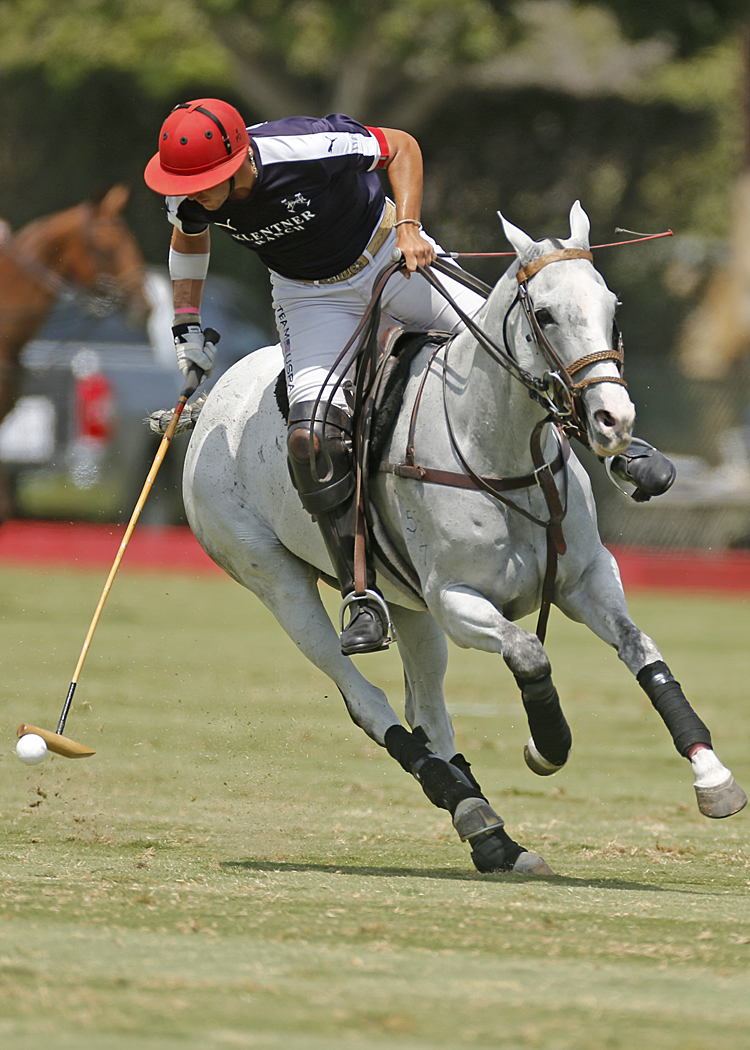It is fast, riveting, elegant, and utterly entertaining, but it can also be confusing to be field-side and not understand the game. Here’s the breakdown.
 Basics
Basics
The object of the game is to move the polo ball downfield, hitting the ball through the goal posts for a score. There are two teams of four players each and two referees, all on horseback. The teams switch directions after each goal is scored so that neither team has a wind, sun, or field advantage. After each goal is scored, the teams come back to the center of the field for a “bowl in”, similar to a face-off in hockey. The polo field is 300 yards long and 160 yards wide (approximately the size of nine football fields), making it the largest field in organized sports.
Chukkers
A polo match lasts about two hours and is divided into six periods, called chukkers. Each chukker runs seven and a half minutes long. A bell or horn is sounded at the seven-minute mark to let the players know 30 seconds remain. If the ball goes out of bounds or is scored in that time, the chukker ends. The team with the most goals at the end of the six chukkers is the winner.
Divot Stomp
During halftime, spectators are invited to go onto the field and participate in the traditional divot stomp to replace clods of turf kicked up by the horses during play, helping to smooth the field for the next half. The divot stomp is often done with a glass of bubbly in hand.
Handicaps
Polo handicaps result from players ranked yearly by their peers. The United States Polo Association has a scale of -1 to 10 goals (10 being the best) that are then assigned as the player’s handicap. Team play is handicapped on the basis of ability and can change from tournament to tournament. If a tournament is a 16-goal tournament, the four players’ handicaps cannot exceed 20. Low-goal polo is considered 0 to 8 goals. Medium-goal polo is considered 8 to 16 goals. High-goal polo, or professional polo--that most exciting and rare of the sport--is 16 to 26 goals in the United States.
Teams & Players
Each team is a mix of professional and amateur players. At the high-goal level of play--such as the teams competing in the Pacific Coast Open--there is typically one amateur player and three professionals. In medium and low-goal polo, the teams are a mix of amateur and professional players. These teams are unique in a sense because the teammates can change depending on the makeup of the team and the handicap of the tournament being played.
Player Positions
Each of the four players is given an area of responsibility designated by a jersey number. The forward is #1; the most defensive player is #4, or the back. (There is no goalie.) The middle players are #2 and #3. The #3 is usually the highest-rated player on the team and the de facto captain. This is the player who leads the offense and coordinates the defense.
Attire
In Santa Barbara, laid-back luxury reigns supreme. Match attire can vary among tournaments, with the high-goal season hosting dressier matches. When in doubt, you can never go wrong with a classic sundress or khakis and a button-down shirt.
Photo Credit: David Lominska

 Basics
Basics